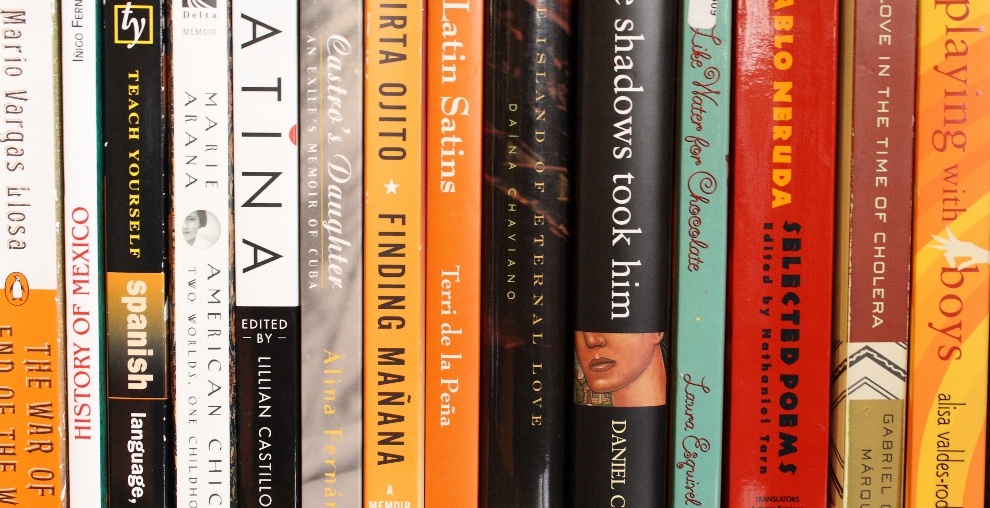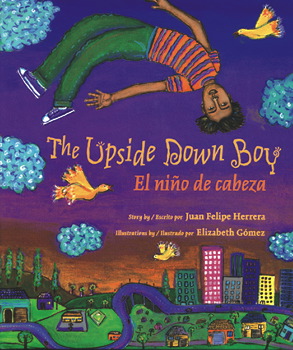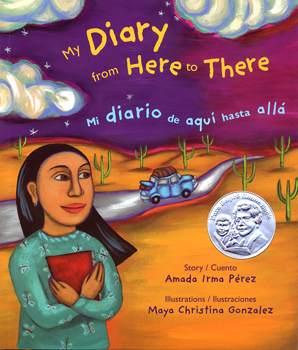Archive for 2011

19
Oct 2011
Children’s Book Press
posted in: Authors, books, Children's Books, UncategorizedI honestly don’t remember many pictures books from my childhood, though I know I read many. I started reading “chapter books” (I forgot that children call them that until my ten-year-old niece said it) when I was eight years old. I lovingly remember books by Laura Ingalls Wilder, Roald Dahl, Judy Blume, Gary Paulsen, and so on. But did I read anything written by a Latin@? No, I didn’t discover that until I found Sandra Cisneros at 14. Now, I know that there must be some childrens and YA books by Latinos out there, but I didn’t find it back then, and I read so voraciously from a young age that I quickly moved onto literary fiction adult titles to satisfy my appetite.
Now that I have my own child, I am interested in finding children’s books that feature Hispanics. So the other day I was delighted to find a whole shelf dedicated to mostly bilingual books in the kid’s section at the public library. (Hey, I live in Alabama – it’s a big deal to find that treasure trove. Our stores’ sections for Latino literature are as limited as the food, which you find in the Asian or beans sections at Wal-mart.)
Anyway, on to these two bilingual books, both by Children’s Book Press, a non-profit publisher of multicultural books for kids.
The Upside Down Boy is by Juan Felipe Herrera. This book is written in a melodious voice, bringing to mind, perhaps, a kid’s magical realism. Kids will love the story of Juanito (based on the author’s life), who moves to a new place and school and has to learn English. With his teacher and family as support, he discovers his gift for poetry and music and learns English. Parents (okay, maybe just me) will go wild for the beautiful lyricism:
“We are finger painting.
I make wild suns with my open hands.
Crazy tomato cars and cucumber sombreros —
I write my name with seven chiles.”
The illustrations are by Elizabeth Gomez. The creative, fantastical images accompany the writing perfectly.
I’m so excited about this author and the other works I saw on his website, and I actually found out that two more are available at my library. I will definitely be reading more by him!
My Diary from Here to There, by Amada Irma Pérez, tells Amada’s story of crossing the border via diary entries. She was as scared as any kid who is moving to a
new country. She finds out that her dad is actually an American citizen. He goes to find work and leaves the family behind for a short time while applying for green cards. César Chávez and the grape boycott make a cameo in the book!
I was impressed by the clear writing that is honest about the scary situations the family faced; but the tone keeps it interesting and wouldn’t freak a child out (I was really wondering how that would pan out when I started reading).
Perez’s website shows two other books, and she also does speaking engagements. I love her final words for tips to aspiring authors: “You ARE a WRITER because you write, not because you publish!”
The book is illustrated by Maya Christina Gonzalez. I loved the vivid colors of the art that has a definite Chican@ style.
no comments17
Oct 2011
The Turkish Lover
posted in: Authors, books, Esmeralda Santiago, Puerto Rico, UncategorizedEsmeralda Santiago’s book The Turkish Lover is about, well, her Turkish lover. If by lover you mean a narcissistic, pathologically lying, philandering, and controlling abuser.
The book starts out with Santiago’s move from Puerto Rico to the U.S. Her mother is scraping by, working as a seamstress, while Santiago begins to navigate the dichotomy between U.S. and Puerto Rican cultures. One scene from the book could have been pulled from my own life, when Santiago’s mother tells her:
“This is why you have to learn English, graduate from high school, and find work in offices, not factories,” she said in a voice unsteady with controlled anger. “So many humiliations, all because I didn’t get an education.”
So of course what Santiago does is exactly the opposite of what is expected from una “nena puertoriqueña decente” – getting a job, moving out, dating, moving to Florida with Ulvi, the list goes on. The mind control begins subtly in New York, when Ulvi criticizes her clothes and mannerisms, expecting her to change them, and then progressively get worse. The split that arises between her and her family and her culture is painful to read about. Santiago writes:
“I never called home because I knew Mami didn’t approve of my life with Ulvi and I didn’t want to hear the reproach in her voice. Except for me, no one in my family was mucho f a correspondent. Mami didn’t have the time to answer letters, and I didn’t know what to say if I were to write one. . . . months went by and I neither spoke to nor heard from anyone in Brooklyn. Bad news, I knew, would find me. Good news would accumulate until the next time we saw each other.”
This book was well-written, but hard to read. It wasn’t the writing but that I was so frustrated with the author – I kept thinking, “No, don’t go back to him! Oh my God, after what happened you’re going back? Why? Why? Why?” But it can’t be as hard as what she went through, slowly extricating herself from Ulvi’s grasp.
Luckily, Santiago was able to slowly break out of the relationship with this Ulvi character and graduate from Harvard. Spoiler alert: I can’t help but share some last lines of the book, which leave you wanting more:
“I was returning to my family free of a man who disdained my people and me. I was returning having exceeded even the most optimistic expectations for a poor girl from a huge family raised by a single mother under the most challenging conditions in a hostil culture and environment. . . . I was so proud of myself, I strutted toward the Departures gates. I had forgotten the Puerto Rican saying that Tata had muttered in our direction whenever we boasted about something we had done: Alábate pollo, que mañana le guisan. Boast now, chicken, tomorrow you’ll be stew.”
Not everybody is able to get themselves out of relationships that are physical or emotionally abusive. If you know someone who is abused, one place you can go for help is the National Domestic Violence Hotline at 1-800-799-SAFE.
no comments15
Oct 2011
Weekend Roundup!
posted in: Weekend RoundupOkay, so I disappeared for a while. I’ve been busy wrapping up Hispanic Heritage Month, this week at two elementary schools. This climate in Alabama dictates that we do our part in celebrating our heritage, highlighting our contributions to our communities, and helping our Hispanic students to feel included. I was at two elementary schools on Thursday, and one video showed me reading a bilingual book (of course!) to a crowd of 480 students (I can’t find the video now, thank God.) But here is a video of those bright and shiny faces at one of the schools, which accompanies the local news story on the event. (By the way, this is the school’s FIRST Hispanic Heritage Month celebration even though they have the highest population of Hispanic students in the city. Ay ay ay.)
So here’s the weekend roundup:
Nuestra Palabra Texas-wide book tour :: via The Venture – Can I use this as an excuse to go home?
Review of Moraga’s A Xicana Codex of Changing Consciousness: Writings, 2000 – 2010 :: via The Feminist Texican – I just discovered this blog and am excited to read more! I’ve read essays by Moraga but haven’t read a full book. I’ll add it to my long list of must-reads.
Tomorrow is National Latino Aids Awareness Day in Michigan :: via Boyne City Gazette – Never heard of this one, but hey, it’s a great issue to address! I think this is a Michigan-only thing.
Watch Lost in Detention on Oct. 18 :: via Presente.org – Watch the organization’s interview with Maria Hinojosa on her documentary on the Secure Communities immigration detention program.
no comments12
Oct 2011
The book that started it all . . .
posted in: Authors, books My interest in Latino literature began with one book, purchased on an unassuming trip to the bookstore when I was about 14 years old. That book was Woman Hollering Creek by Sandra Cisneros. Reading this book made me realize that there wasn’t a generic, white “normal” in which books are written. After reading the book, I realized that books can convey a sense of culture in such a subtle way that just “gets it.” Like most great books, I read and loved this book when I was young, and re-reading it over the years always conveys a new sense of meaning. Even now, re-reading the stories in preparation for writing this post, I had new understanding while reading the book.
My interest in Latino literature began with one book, purchased on an unassuming trip to the bookstore when I was about 14 years old. That book was Woman Hollering Creek by Sandra Cisneros. Reading this book made me realize that there wasn’t a generic, white “normal” in which books are written. After reading the book, I realized that books can convey a sense of culture in such a subtle way that just “gets it.” Like most great books, I read and loved this book when I was young, and re-reading it over the years always conveys a new sense of meaning. Even now, re-reading the stories in preparation for writing this post, I had new understanding while reading the book.
Woman Hollering Creek is a collection of short stories – vignettes, really – that highlight stories about different women. “My Lucy Friend Who Smells Like Corn” opens with a little girl:
Lucy Anguiano, Texas girl who smells like corn, like Frito Bandito chips, like tortillas, something like that warm smell of nixtamal or bread the way her head smells when she’s leaning close to you . . .
I think I gasped the first time I read those lines. Somebody else knows that there’s always that one person who always smells like the steam rising from a pot of tamales! Keep reading and you’ll discover a writing that is vivid and peppered with phrases in Spanish. The way I talk. This is the first book I ever read like that.
The stories start out with young voices and as you get further through the book the narrators become older, with complex problems. “One Holy Night” is the story of a young girl, seduced by an older man who disappears when she becomes pregnant:
“We heard nothing for a long time. Abuelita took me out of school when my uniform got tight around the belly and said it was a shame I wouldn’t be able to graduate with the other eighth graders.”
Another sucker punch! This is the kind of writing I live for – something raw and so real you almost can’t believe it.
This time around, the title story “Woman Hollering Creek” had a profound meaning to me, because now I am a mother. If you are a mother, you know that your whole perspective on the world changes the moment you give birth. This is the story of Cleófilas, a Mexican immigrant who ends up alone in the U.S. with an abusive husband, a son, and a baby on the way. When she moves into the town, she takes note of the strangely named creek (which is real, by the way). As time goes on, she begins to wonder if it is really named after La Llorona.
“Perhaps La Llorona is the one they named the creek after, she thinks, remembering all the stories she learned as a child.
La Llorona is calling to her. She is sure of it. Cleófilas sets the baby’s Donald Duck blanket on the grass. Listens. The day sky turning to night. The baby pulling up fistfuls of grass and laughing. La Llorona. Wonders if something as quiet as this drives a woman to the darkness under the trees.”
That darkness is something I think that all mothers know about but is a taboo topic. The spectre of depression that looms over a mother and her newborn child. The power of birth is so forceful I think it is only natural that the flip side of all that joy is just as big, making it a terrible thing.
Do you remember La Llorona from your childhood? My torturous cousins blended the stories of La Llorona and Bloody Mary, saying that she would appear if you lit candles in a dark bathroom and looked in the mirror and flushed the toilet and goodness knows what else. I think I ran away from the toilet each time I flushed it for the next 10 years.
Well, for me this is the book that started my quest to find others like it. I’ve read many more, and I have a giant stack plus a library list that I’m planning on reading — and I’ll be blogging about it all. Do you have a similar story? Tell me about it!
no comments11
Oct 2011
Watch Women, War & Peace on PBS today!!!
posted in: DocumentariesI was finishing a book review, until I came across the five-part series Women, War & Peace airing on PBS. I was going to simply save it for Friday’s weekend roundup, but the series starts TODAY and it’s on an important topic (also, the trailer looks amazing). The series is about how war affects women (and children). It’s a sad statistic I’ve heard before – the majority of casualties of war 100 years ago were soldiers, but today the majority of war casualties are women and children.
What does this have to do with Latinos? Well, the fourth part of the series, The War We are Living, focuses on Columbia, where war over gold still rages in rural areas. Two women are holding their ground.
Here are more links to related reports about Colombia on the series web page, mostly concerning paramilitary and narco-trafficking:
*Interview with Ingrid Betancourt, former hostage
*A PBS Article and a Washington Post report about secrecy in federal criminal prosecutions of Colombian drug lords
*More about Colombian paramilitary in the U.S. Court System
*Two visits to Colombia, reported here and here
I went to check my local listings and Alabama Public Television has tons of sharing icons – including one for each episode where I can add it straight to my Google calendar. I did it for every episode.
no comments





























